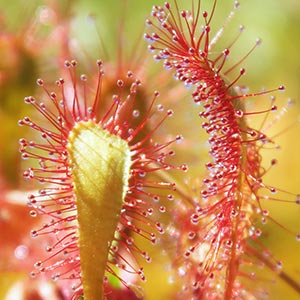Drosera anglica
Drosera filiformis
droséra d'angleterre, English sundew, giant sundew, great sundew, line-leaf sundew, long leaf sundew
dew-threads, thread-leaf sundew
erect;
stipules entirely adnate to petioles, 5 mm, margins fimbriate along distal 1/2;
petiole differentiated from blade, 3–7 cm, glabrous or sparsely glandular-hairy;
blade obovate to elongate-spatulate, 1.5–3.5(–5) cm × 3–7 mm.
erect;
stipules adnate to petioles for entire length, 10 mm, margins fimbriate, forming woolly appearance of cormose base;
petiole not differentiated from blade;
blade filiform, 8–25(–30) cm × 1 mm, surfaces glandular-hairy, trichomes red to reddish purple, drying dark brown.
1–12-flowered;
scapes 3–25 cm, glabrous.
4–12(–24)-flowered;
scapes 6–26 cm, glabrous.
glandular-pilose.
8–10 mm diam.;
sepals connate basally, oblong, 5–6 × 4–5 mm, minutely glandular-denticulate;
petals usually white, rarely pinkish, spatulate, 5–6 × 2–3.5 mm.
10–20 mm diam.;
sepals connate basally, oblong to elliptic, 4–7 × 2–2.5 mm, glandular-pilose;
petals pink to purple-lavender, broadly ovate, 7–10(–12) × 5–15 mm, apical margins erose.
4–6 mm, minutely tuberculose.
5–6 mm.
black, sigmoid-fusiform, 1–1.5 mm, length 1–2 times width, longitudinally striate-areolate.
black, ellipsoid, abruptly caudate at both ends, 0.5–0.8 mm, coarsely crateriform, pits in 16–20 lines.
= 40.
= 20.
Drosera anglica
Drosera filiformis
Drosera anglica is a boreal species that occurs on calcareous substrates. It often grows with D. rotundifolia in peat bogs, and with D. linearis and D. rotundifolia in marl fens, especially in the Great Lakes region. C. E. Wood Jr. (1955) presented a strong case for the hybrid origin of D. anglica, suggesting that it arose as a fertile amphiploid hybrid between D. rotundifolia and D. linearis. It is the only tetraploid North American species of Drosera with 2n = 40. The sterile hybrid D. rotundifolia × D. linearis may be found whenever these species grow together. To avoid confusion, and because a formal name for the sterile hybrid has not been published, it should not be called Drosera ×anglica Hudson, as is commonly done. According to D. E. Schnell (2002), the fertile species may be distinguished from the sterile hybrid by its wider flowers (8–10 mm versus 6–7 mm) and wider scapes (1.5–2 mm versus 1–1.2 mm).
The hybrid between Drosera rotundifolia and D. anglica is a sterile triploid, and has been formally named Drosera ×obovata Mertens & W. D. J. Koch.
Because Drosera longifolia Linnaeus cannot be convincingly typified and has been so often used for plants of D. anglica and D. intermedia in the literature (F. E. Wynne 1944), the name D. longifolia has been rejected as ambiguous.
Drosera anglica is found in the Aalakai Swamp at 1500–2000 meters on the Hawaiian island of Kauai (perhaps brought by migrating birds from Alaska); it is otherwise found in cold northern climates. D. E. Schnell (2002), who has grown the Kauai plants from seed, postulated that the high elevation provides a cooler temperature, and noted that plants from there do not form winter hibernaculae but only smaller winter rosettes.
(Discussion copyrighted by Flora of North America; reprinted with permission.)
Drosera filiformis is disjunct in the outer Coastal Plain, from Nova Scotia and Connecticut to Maryland, southeastern North Carolina, and Bay and Washington counties, Florida. The species has been reported from South Carolina, but no specimens from there have been seen. It is introduced in Caroline County, Virginia, and Preston County, West Virginia, and possibly other localities peripheral to its range; it is short-lived in some localities. B. A. Sorrie (1998b) gave a detailed account of the distribution and habitats of D. filiformis as well as convincing evidence that D. tracyi is a distinct species.
The species is very easy to cultivate, and the cormose-based clumps multiply and may be divided while dormant.
(Discussion copyrighted by Flora of North America; reprinted with permission.)
- Local floras:
BC,
CA,
OR,
WA
- Local Web sites:
CalFlora,
CalPhotos,
Flora NW,
Go Botany,
MI Flora,
MN Wildflowers,
PNW Herbaria
WildflowerSearch
iNaturalist (observations)
USDA Plants Database
- LBJ Wildflower Center
- SEINet
- Plants of the World Online
- Encyclopedia of Life
- Wikipedia
- Google Image Search


